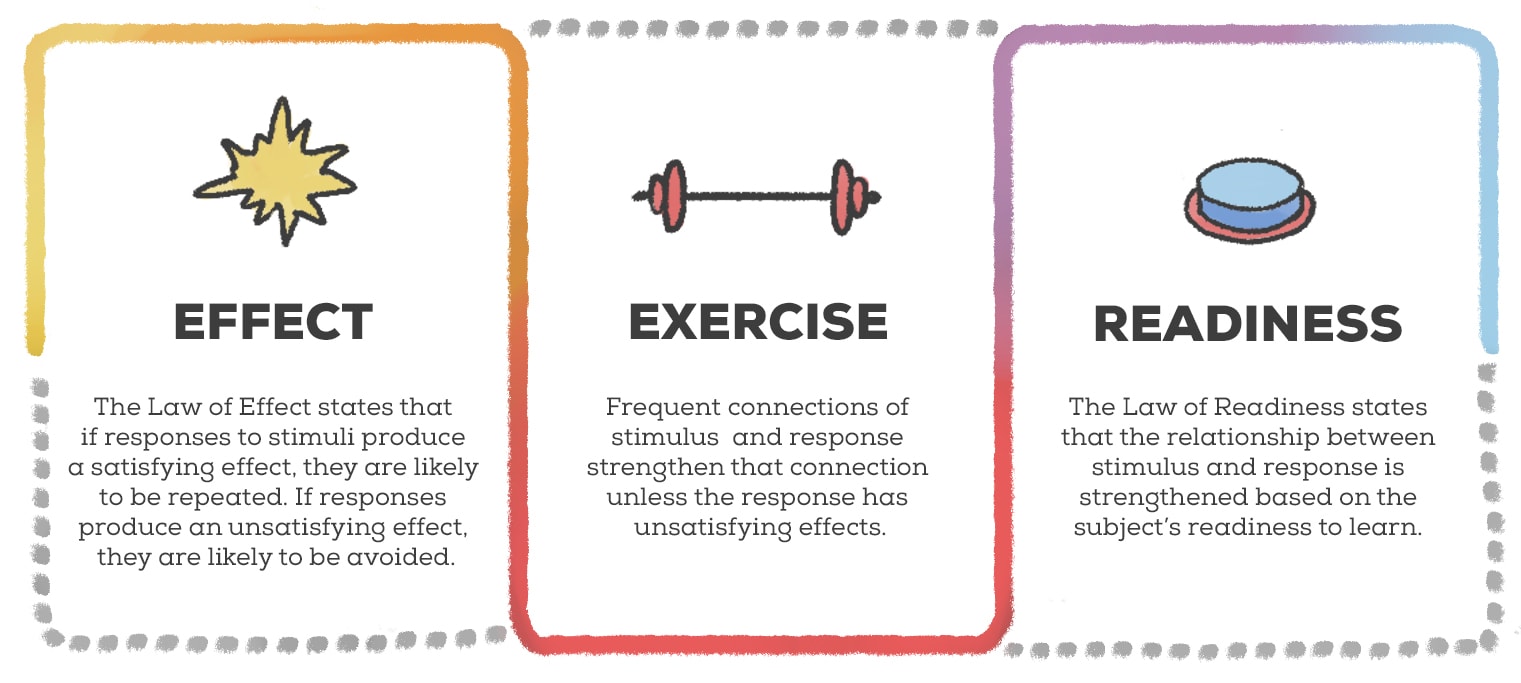Thorndike Used Which Term to Describe Behaviors
This evaluation led Thorndike to conclude that animals learn solely by trial and error or reward and punishment. Thrusting its paws out through any opening and clawing at everything it tries to reach.

Operant Conditioning Module 15 Operant Conditioning A Type Of Learning In Which The Frequency Of A Behavior Depends On The Consequence That Follows That Ppt Download
His theory has been applied to learning and education tools.

. The ability to recognize how one would act in a specific situation according to the Law of Effect The term used to describe the technique that Thorndike. Tap card to see definition. Analyst forecasts and herding behavior.
Chris Sawyer MEdBCBA. Click card to see definition. View Notes - personalityTerm.
Thorndike used the theory of connectionism to learn about animal and human behavior. Essentially rewarded behaviors are often repeated and those behaviors that are not rewarded are less likely to occur in the future. Skinners ideas were based on Edward Thorndikes law of effect which stated that behavior that elicits positive consequences will.
Chapters 3 and 4 in Human Learning describe the work of three prominent early behaviorists. Taking something away to reduce a behavior EX. Edward Thorndike 1898 is famous in psychology for his work on learning theory that lead to the development of operant conditioning within Behaviorism.
Cats would be put inside the puzzle boxes and they would have to figure. Review of financial studies 71 97-124. September 19 2018.
The defining factor of reinforcement theory is of course reinforcement which can be either positive or negative. Thorndike used the cats behavior in a puzzle box to describe what happens when all beings learn anything. Operant behavior was the term Skinner used to describe a behavior that is reinforced by the consequences that follow it.
In studying problem solving behavior in kittens Thorndike used which term to describe behaviors they displayed to escape an enclosure by pulling a string on a latch. The addition of some stimulus that serves to reduce a behavior. Robert Thorndike used the term social intelligence to describe the skill of.
Whereas classical conditioning depends on developing associations between events operant conditioning involves learning from the consequences of our behavior. Click again to see term. Edward L Thorndikes law of effect theory focuses on behavior and consequences based on certain behavior.
All learning involves the formation of connections and connections were strengthened according to the law of effect. Edward Thorndike was the son of a Methodist minister and grew up in Massachusetts. Tap again to see term.
Ivan Pavlov Edward Thorndike and B. Thorndike RL Stein S 1937 An evaluation of the attempts to measure social from COMMUNICAT 2018 at Stanford University. He was the one that coined the term law of effect which is a theoretical precursor to the process of reinforcement.
Observing these changes in the cats behavior led Thorndike to develop his law of effect the principle that responses that create a typically pleasant outcome in a particular situation are more likely to occur again in a similar situation whereas responses that produce a typically unpleasant outcome are less likely to occur again in the situation Thorndike 1911. In studying problem solving behavior in kittens Thorndike used which term to describe behaviors they displayed to escape an enclosure by pulling a string on a latch. The first social psychologist to identify and name this effect was Edward Thorndike.
If youve heard the name Edward Thorndike you are probably aware of the importance this psychologist had on early behavioral science. The essence of the. Taking away a preferred item paying a fine for speeding loss of recess.
While he was a very successful student he initially disliked his first psychology course. John Watson used which term to describe the study of behavior. Those consequences play an important role in whether or not a behavior is performed again.
Thorndike used puzzle boxes that cats had to escape to study the consequences of behavior Thorndike created puzzle boxes. Thorndike observed that the cat performed a number of actions when it was placed in the puzzle box it. Learning of complex behaviors by proposing that such behaviors are actually.
1 The use of the term habit can be traced back to the writings of an early cognitive psychologist William James 1890. Strikes anything loose and shaky. Describe Thorndikes Law of Effect Responses that are followed immediately by a satisfier tend to be stamped in.
Thorndike demonstrated his principle of Law of Effect using the puzzle box experiment Superstitious behavior is the result of accidental reinforcement Successive approximation or shaping has many applications specifically with regard to behavior modification in the classroom Skinner used the term operant conditioning or instrumental conditioning to. Clawing and biting the bars or wires. The theory is also used in intelligence and aptitude testing.
In 1920 he presented his theory of the halo effect in an article called A Constant Error in Psychological Ratings published in the Journal of Applied Psychology. As a result of testing and research Thorndike concluded that learning is significantly affected by cause and effect. Edward Thorndike was a psychologist who developed the law of effect.
Squeezing through any opening. It looks at individuals behavior and what determines that behavior and what maintains the behavior or what diminishes behavior. Like many other psychologists of his time Thorndikes interest in psychology grew after reading the classic book The Principles of Psychology by William James.

Thorndike S Stimulus Response Theory Of Learning Definition Examples

31st August 1874 Edward Thorndike Was Born A Pioneer Within The Field Of Educational Psychology Psychol Psychology History Of Psychology Psychology Student

Classical Conditioning Operant Conditioning And Observational Learning Learning Conditioning Watson Thorndike Behavior Reinforcement Skinner Operants Ppt Download
No comments for "Thorndike Used Which Term to Describe Behaviors"
Post a Comment